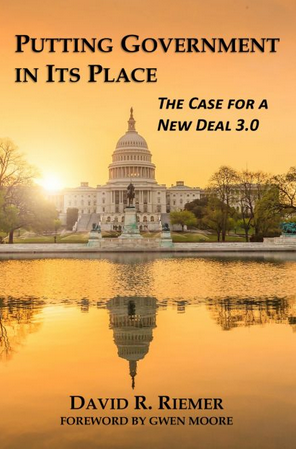Revisiting the New Deal
“This is preeminently the time to speak the truth, the whole truth, frankly and boldly. I am prepared … to recommend the measures that a stricken nation in the midst of a stricken world may require.”
Franklin D. Roosevelt, 1st Inaugural Address, March 4, 1933
The truth is: we must revisit and fix the New Deal.
The New Deal is the starting point for any serious examination of the place of American government. The New Deal revolutionized the functions, financing, and forms of government, especially the federal government. Eighty years later, the New Deal’s premises, its structures, and its language dominate our thinking about government. Like it or not, we are all children of the New Deal.
The New Deal, as defined here, refers both to the historic New Deal of 1933-1937 and more broadly to the dramatic expansion of governmental activity that took place in the United States throughout the last seven decades of the 20th century and the first decade of the 21st century. The New Deal thus writ large can be thought of as the majority of laws and programs created at all levels of government, but especially at the national level, between two famous bookends: FDR’s Inaugural Address of 1933 and President Obama’s signing of the Affordable Care Act (aka ObamaCare) in 2010. Learn More ->
It was far from clear to Franklin Roosevelt as he campaigned in 1932, however, what exactly the New Deal would become. Even as late as Inauguration Day in March of 1933, its shape was fuzzy. FDR and his New Deal allies might have gone in sharply different directions as they fashioned their policy approach. Learn More. ->
Within days, however, the contours of the New Deal began to take shape. As Frances Perkins--Roosevelt's Secretary of Labor (and first woman to hold a cabinet position)--put it, the New Deal "emerged." FDR and his allies, as they enacted program after program to stem and reverse the nation’s economic collapse, did not necessarily group the policies they pursued into well-defined categories. But 80 years on, it is fair to say that America’s dramatic expansion of the role of government occurred mainly within four distinct “clusters” of public policy: (1) economic security (including equality of opportunity), (2) poverty remediation, (3) market regulation, and (4) market intervention. Learn More ->
With the benefit of hindsight, we can see what policy shortcomings the original New Deal created and the New Deal writ large has perpetuated.
Two pairs of the New Deal’s policy clusters work at cross-purposes. Its economic security policies fail to sync up with its poverty remediation policies. Its market regulation policies conflict with its market manipulation policies.
The first policy cluster—centering on economic security--sought to absorb the shocks that inherently arise from the major risks of a private labor market: worker injury and disability, unemployment, and inadequate old-age income and health insurance. Another key thrust of this policy cluster was to equalize opportunity, e.g., by making it possible for all GIs to attend college.
The central purpose of this cluster of economic security and equal opportunity programs is to prevent Americans from falling into poverty, stabilize them economically, and help them and their children succeed in the economy and life. The policy cluster's major money programs provide universal and stable benefits. You do not have to be poor to get Worker's Compensation, Disability Insurance, Unemployment Insurance, or Social Security. The amount of your payment does not fluctuate with income. On the health insurance side, the level of your Medicare coverage, and thus your access to doctors and hospitals, also does not depend on income. And your access to K12 schools (and to college at least under the GI bill) is intended to be equal, regardless of income.
Yet the New Deal's cluster of economic security and equal opportunity programs has major gaps and serious flaws.To name a few: it allows high levels of unemployment and poverty; it leaves tens of millions uninsured, while allowing health care costs to soar; and it fails to provide equal educational funding, fails to educate tens of millions of children at the K12 level, and saddles millions of college students with crushing debt.
In addition, the cluster of economic security programs created during the New Deal writ large has left distinct groups of Americans behind, particularly African Americans. They are less likely--especially young black men--to find work, or qualify for Unemployment Insurance, or have access to doctors and hospitals, or be able to send their children to well-funded schools.
Rather than directly tackle these gaps and shortcomings in the economic security system, the federal government over the decades plugged some of the holes with narrowly "targeted" welfare programs for the poor. Begun under President Herbert Hoover; expanded under FDR; and greatly enlarged after World War II; successive waves of the New Deal writ large created a separate cluster of poverty-requiring "relief" programs that by the 1950s came to lumped under the general heading of "welfare."
This second policy cluster operates on entirely contradictory principles. Welfare programs provide non-universal "categorical" benefits, often for narrow subsets of the poor (and in time the "near-poor"). Percentages of poverty largely determine the availability and amount of help.
By design, poverty-requiring welfare programs do not reduce poverty. On the contrary, they trap the poor in poverty as a condition for getting help. Because welfare benefits typically decline whenever the poor work or wed, welfare programs create an incentive to lie about income, avoid work, and refrain from marriage...since reporting additional income, working more hours, or getting married could risk loss of assistance.
To make matters worse, this second policy cluster reinforces racism. African Americans and other minority groups have simultaneously suffered the most from lower incomes and qualified less for "first cluster" programs that provided universal benefits regardless of income. As a result, African Americans and other minority groups have needed to turn in higher proportions to poverty-requiring welfare programs in order to survive. While blacks, Hispanics, and Native Americans seldom added up to 50% or more of welfare recipients, it was easy--and remains easy--to stigmatize racial and ethnic minorities as the prime source of the "undeserving poor" on welfare, and then go on to denigrate minority groups as a whole. Thus, racial bias--never far below the surface in American politics--continuously feeds on the New Deal's second policy cluster of poverty-requiring welfare.
The third policy cluster of New Deal programs—involving market regulation—aimed to create effective markets that no longer wrecked the environment, damaged and mistreated workers, harmed and tricked consumers, or swindled and misled investors. The ultimate intent was to ensure that markets worked efficiently to allocate resources to the most productive producers of goods and services.
But the fourth policy cluster—market manipulation—massively intervened to steer the market in centrally-planned directions, by subsidizing politically-favored forms of consumption and investment.
Correcting the two sets of contradictions--that is: (A) the first cluster's provision (or intended provision) of broad-based economic security and equal opportunity that aims to shield Americans from poverty versus the second cluster's requirement that Americans must be poor (or near-poor) to gain meager welfare benefits, and (B) the third cluster's creation of market regulation that protects the environment, workers, consumers and investors, and that aims to put consumers and investors in charge of markets that efficiently allocate resources versus the fourth cluster's creation of massive government manipulation of the market, with politically-favored subsidies distorting the market's shape, altering its course, and undermining its efficiency---is not merely a matter of neatness. The two contradictions do damage to the well-being of the American people. They perpetuate racial disparities and economic inequality. Both contradictions also subvert the success of the our economy. They undermine the wealth of the nation. Learn More ->
We have no choice but to revisit the New Deal, and fix its gaps and flaws, in order to put American government in its proper place. Most importantly, its four policy clusters should be collapsed into two.
Specifically, the economic security cluster, including equal opportunity in health and education, should be expanded and strengthened…while the poverty remediation cluster is phased out. Turn to ->
At the same time, the market regulation cluster should be improved...while the market manipulation cluster is would down. Turn to ->
FDR, the great innovator, would be fascinated. He might even approve.

